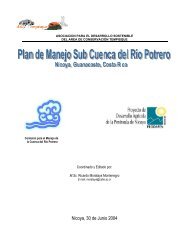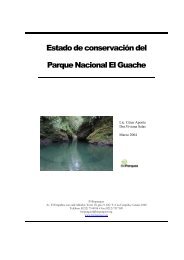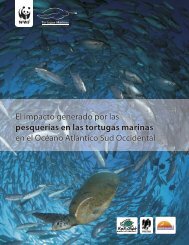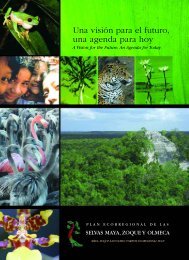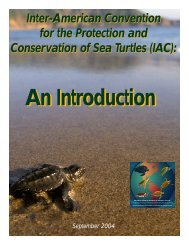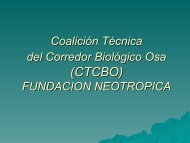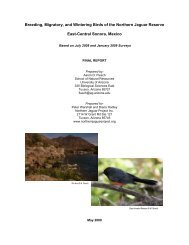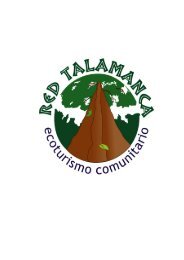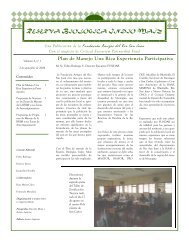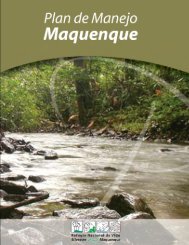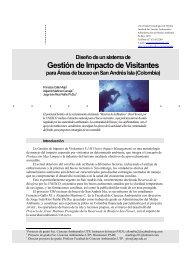Volumen 14(3) Noviembre de 2010 - Eco-Index
Volumen 14(3) Noviembre de 2010 - Eco-Index
Volumen 14(3) Noviembre de 2010 - Eco-Index
Create successful ePaper yourself
Turn your PDF publications into a flip-book with our unique Google optimized e-Paper software.
No ta CientíficaIm p o r ta n c i a Am b i e n ta l y So c i a l d e l Co r r e d o r Bi o l ó g i c o Me s oa m e r i c a n o e nMé x i c oEn v i r o n m e n ta l a n d So c i a l Im p o r ta n c e o f t h e Me s oa m e r i c a n Bi o l o g i c a lCo r r i d o r in Me x i c o*Pedro Álvarez-Icaza Longoria y Martha Ileana Rosas Hernán<strong>de</strong>zDirector General y Coordinadora <strong>de</strong> Asuntos Internacionales, respectivamente, <strong>de</strong>l Corredor Biológico Mesoamericano-México (CBMM),programa <strong>de</strong>pendiente <strong>de</strong> la Comisión Nacional para el Conocimiento y Uso <strong>de</strong> la Biodiversidad (Conabio) <strong>de</strong> México. Liga Periférico-InsurgentesSur, Núm. 4903, Col. Parques <strong>de</strong>l Pedregal, Delegación Tlalpan. C. P. <strong>14</strong>010, México, Distrito Fe<strong>de</strong>ral*Autor <strong>de</strong> correspon<strong>de</strong>ncia: pedroalvarezi@cbmm.gob.mxFecha <strong>de</strong> recepción: 7 <strong>de</strong> abril <strong>de</strong> <strong>2010</strong> - Fecha <strong>de</strong> aceptado: 10 <strong>de</strong> octubre <strong>de</strong> <strong>2010</strong>Re s u m e n. El artículo ofrece un breve recuento histórico <strong>de</strong>l Corredor Biológico Mesoamericano en la región y,especialmente en México (CBM-M). El objetivo es presentar <strong>de</strong> manera breve y puntual algunos logros alcanzados para esteCorredor en México, en la consolidación <strong>de</strong> políticas públicas para el <strong>de</strong>sarrollo sustentable. Para ello se expone el ProyectoDesarrollo Rural Sustentable para la Región <strong>de</strong> Marqués <strong>de</strong> Comillas, Chiapas, cuyos ejes parten <strong>de</strong> la convicción <strong>de</strong> quela conservación <strong>de</strong> los ecosistemas y su biodiversidad no es posible si no se trabaja al mismo tiempo en reducir la pobrezay en fortalecer la viabilidad económica <strong>de</strong> las poblaciones rurales en un marco <strong>de</strong> transversalidad <strong>de</strong> políticas y accionespúblicas. Como conclusión, se incluyen algunas reflexiones sobre el futuro <strong>de</strong>l Corredor Biológico Mesoamericano enMéxico y en la región mesoamericana. La importancia <strong>de</strong>l artículo resi<strong>de</strong> en que, a nueve años <strong>de</strong> iniciadas las activida<strong>de</strong>s,se pue<strong>de</strong> concluir que las acciones <strong>de</strong>l CBM-M han <strong>de</strong>mostrado que los corredores biológicos son herramientas útiles<strong>de</strong> manejo sostenible <strong>de</strong>l territorio para la conservación <strong>de</strong> la biodiversidad y, sobre todo, que es posible conciliar elcuidado <strong>de</strong> la naturaleza con el <strong>de</strong>sarrollo económico sostenible <strong>de</strong> sus pobladores, lo que abre una puerta para replicar laexperiencia en otros espacios <strong>de</strong> México y la región mesoamericana.Palabras clave: corredores biológicos, políticas públicas, conservación, <strong>de</strong>sarrollo sostenido.Ab s t r a c t. This article offers a brief historical account of the origin of the Mesoamerican Biological Corridor in theregion, and especially in Mexico (M-MBC). The objective is to present briefly some accomplishments of this Corridor inMexico (M-MBC) in strengthening public policies for sustainable <strong>de</strong>velopment in the region. As an example, the articlefocuses on the Sustainable Rural Development Project for the Region of Marqués <strong>de</strong> Comillas, Chiapas, based on theconviction that the conservation of ecosystems and their biodiversity is not possible without working simultaneously onthe reduction of poverty and strengthening the economic viability of rural populations within a framework of policymainstreaming and public action. The conclusion inclu<strong>de</strong>s some reflections on the future of the Mesoamerican BiologicalCorridor in Mexico and Mesoamerican region. The significance of the article resi<strong>de</strong>s in that it can be conclu<strong>de</strong>d that theactivities of M-MBC, which started nine years ago, have shown that biological corridors are useful tools for sustainableland use, for biodiversity conservation and, above all, it is possible to reconcile conservation with sustainable economic<strong>de</strong>velopment, opening the opportunity to replicate the experience in other areas of Mexico and Mesoamerica.Key words: biological corridors, public policies, conservation, sustainable <strong>de</strong>velopment.




